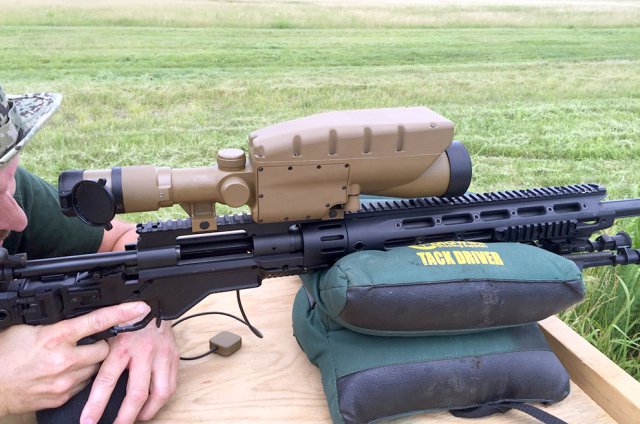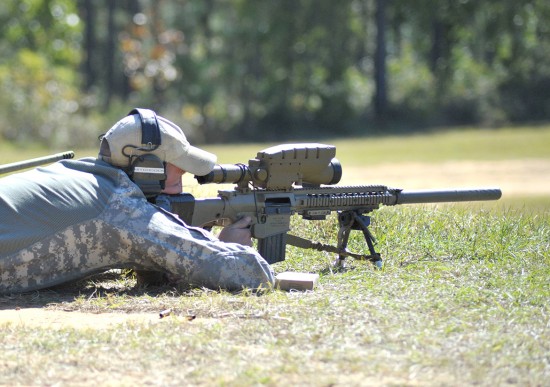In movies, we often see snipers aiming at their targets, placing the reticle of their scope at exactly the spot they want the target to impact, and rarely making any substantial adjustments to the knobs adorning the telescope like lens attached to the tops of their rifles. Often, they’ll omit what is arguably one of the most valuable tools a sniper has – his spotter. Military spotters are usually equipped with a more powerful scope than the sniper has on his rifle, and between the two of them, the sniper/spotter team is able to observe the objective and make adjustments based on variables like wind speed and the distance to the target in order to maximize their chances of success.
In movies, the difficult part of being a sniper is often omitted; presenting us with talented distance shooters as though the skill set is akin to Harry Potter’s chosen-one-ness; based on an invisible power that us regular folks simply don’t have. In reality, being an effective sniper requires a great deal of patience, a high level of observational skills and a mastery of mathematics in conjunction with traditional talents with a firearm.
It’s this ability to balance the mental and physical challenges of the task that make some better suited for the job than others, but the Army has a plan to make the process a whole lot easier – and in the years to come, it could turn every American infantryman into a sniper more like the ones we’ve seen on TV than the ones we can currently find in the field.
In an effort to take some of the more complicated aspects of distance shooting out of the equation, the Army is working to develop an integrated fire control system that mounts on a rifle just like a traditional scope. However, unlike existing scopes, the Ballistically Optimized Sniper Scope (or BOSS) can accurately assess the distance to a target, compensate for a number of variables, and place the reticle where the round will actually impact, rather than where the rifle is currently aimed.
“To improve sniper effectiveness, especially at extended distances, we need to find a way to increase accuracy by reducing aiming errors, and minimize the time for the shooter to figure out where to correctly aim his weapon,” said Regina Stonitsch, Assistant Product Manager for BOSS at Project Manager Soldier Weapons. “We believe the answer could be the BOSS Project.”
In effect, it takes all of the math out of the game and gives the sniper a vastly simplified process when setting up to take a shot. This means a significant reduction in the time it takes for a capable sniper to achieve his objective and reduces the likelihood of circumstances changing while the sniper/spotter team works to assess the situation.
“Since sniper rifle and ammunition technologies are unlikely to change considerably in the foreseeable future, we’re concentrating our efforts on developing a revolutionary fire control system that will provide a leap in shooter performance and likewise a big return on investment,” Stonitsch said.

The BOSS sight system mounts on a rifle via the Picatinny Rail, and incorporates a variable power 6-22x magnification optic with an eye-safe laser ranger finder and several environmental sensors. The onboard computer interprets the data gathered by the full suite, including a ballistic calculator that takes the type of ammunition being used into account and gyroscopes that feed it data on platform orientation and other firing position variables.
All of the math is done by the scope as the sniper maintains the target in his vision, allowing for increased situational awareness and reduced chances of losing sight of the target while making adjustments. The BOSS scope then provides an updated reticle based on the variables it has assessed – meaning the sniper has to make no adjustments to the sights whatsoever. He can then place the reticle on the target with certainty that it is showing him exactly where the round will impact. In the event of a power failure, the BOSS sight system can serve as a traditional rifle scope, allowing the sniper to maintain combat effectiveness even if the equipment goes down.
According to Stonitsch, the BOSS sight system has been tested on personnel sized targets from the maximum range allotted by the weapon systems currently employed by Army snipers, but is actually capable of making adjustments for distances far greater than current sniper systems will allow for. The current limitations of the BOSS sight system is not the system itself, but the weapons it can be mounted on. Tests have shown the BOSS system to reduce engagement time on the target by an average of fifty percent across the board, and eliminates the need for sniper teams to carry their traditional kit of items used to perform ballistic computations.
Already have an account? Sign In
Two ways to continue to read this article.
Subscribe
$1.99
every 4 weeks
- Unlimited access to all articles
- Support independent journalism
- Ad-free reading experience
Subscribe Now
Recurring Monthly. Cancel Anytime.
At 3.5 pounds the BOSS sight system isn’t heavy, but it’s not light or cheap enough to be distributed to the masses. At present, it’s intended only for elite sniper teams, but as technology permits, the BOSS system could become smaller and cheaper, allowing for more of America’s service members to be outfitted with the system.
“The BOSS is currently designed for snipers, but its technologies can be easily adapted to other small arms weapon systems,” Stonitsch said. “It could be a game-changer for our Warfighters by taking the guesswork out of aiming and making virtually anyone a marksman with the touch of a button.”
Current projections suggest the BOSS sight system will see deployment with Army snipers as soon as 2020.
Images courtesy of the US Army










